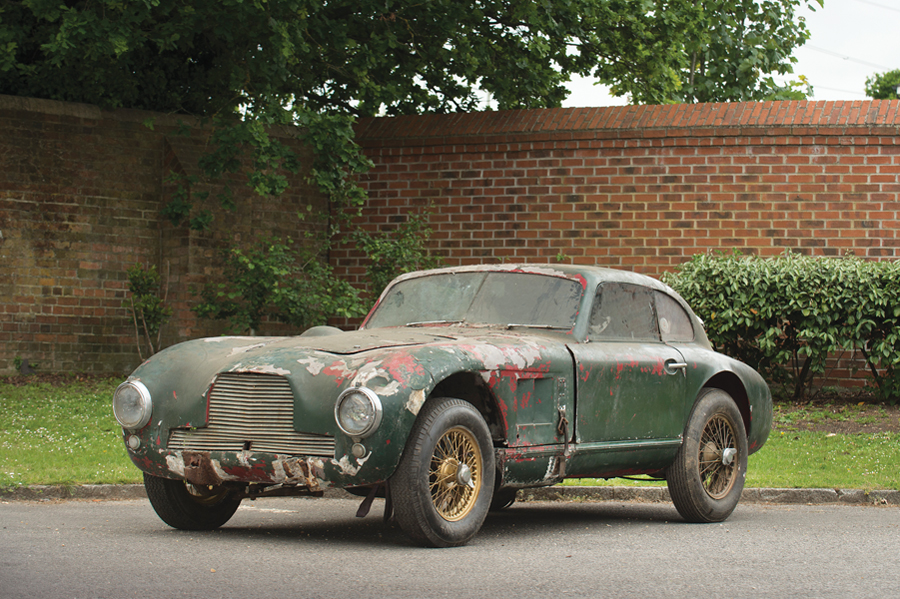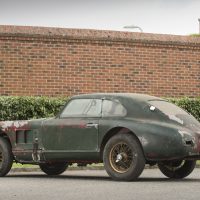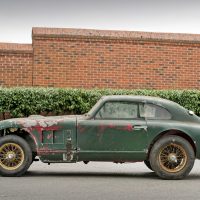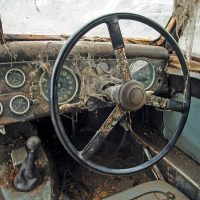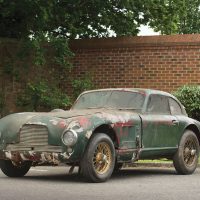SCM Analysis
Detailing
| Vehicle: | 1949 Aston Martin DB Team Car |
| Years Produced: | 1949 |
| Number Produced: | Three |
| Original List Price: | This car was a prototype/racer and not sold |
| SCM Valuation: | Median price to date, $901,579; high sale (this car), $901,579 |
| Tune Up Cost: | $500 |
| Chassis Number Location: | Plate riveted to firewall |
| Club Info: | Aston Martin Owners Club |
| Website: | http://www.amoc.org |
| Alternatives: | 1948–52 Ferrari 166 Inter, 1950–51 Maserati A6G 2000, 1953–55 Frazer Nash Le Mans coupe |
| Investment Grade: | A |
This car, Lot 241, sold for $891,319, including buyer’s premium, at Bonhams’ Festival of Speed sale near Chichester, U.K., on June 24, 2016.
It was, as you can see from the photographs, a shed, to use the British technical term. Though the major panels still resembled the shape of the car, everything was bent, distressed or rusted, although the aluminum skin looked savable.
The motor was incomplete, though there were enough spares, including three heads and two blocks, to assemble probably two complete units, which is handy because the engine in this car is the incredibly rare 4-cylinder devised by Claude Hill, and this is the only survivor so fitted.
It came with a choice of carburetors in a box, SUs or Webers, plus an aluminum sump, and retained the twin electric fans in front of the radiator.
The interior, though full of cobwebs, wasn’t too bad. The instruments were all there — and would probably clean up. The leather might even recover with a careful clean and feed, because surely during this car’s restoration the priority will be to keep as much of the original as possible.
The 48-gallon endurance fuel tank had gone missing, and the grille treatment had been modified since its Works competition days, but it retained the brackets and holes for the regulation Le Mans seals on the radiator cap and oil filler. These survive from — and represent — a bygone era.
A lovely period shot in the catalog shows Lance Macklin slowing during the Spa 24 Hours, arm out of window to collect a beer from a roadside bar, with not a barrier in sight as patrons sit out front, just feet from a live racing track which was a public road for the rest of the year.
Parked in a garden — and then stolen
Part of the reason the car became this dilapidated was that upon disposal by Aston Martin in 1949 or 1950 after those two endurance races, it was used in various hands for a decade of club racing before being stashed in a garden for many years.
Christopher Angell, a Life Member of the Aston Martin Owners Club who joined in 1950, bought the car in 1965, planning to restore it one day. As his health deteriorated, so did the car’s condition, until it was stolen from his garden in Hinxworth, Hertfordshire, in 2002.
It took 13 years for the police to recover it, having tracked it down to a storage facility in Eindhoven, Holland. It had been offered for sale at an auction during that time, although it was withdrawn as soon as the story of its theft emerged. The car recently came to light as a result of being put up as a surety for a loan.
Christopher Angell died in 2003, before it was found. According to local paper the Hertfordshire Mercury, quoting his relative Ashley Mack, the rightful owner and vendor of the car, “Christopher was devastated by the theft of his car, and just before he died in 2003, he was still asking, ‘Has that nice policeman got my car yet?’”
It returned home only in 2016.
A DB2 prototype with stellar race history
This is a very significant car.
As Bonhams’ catalog noted: “It is an outstanding survivor from not just one 1949 24-Hour race — but two — both of which it finished in significant positions, 7th at Le Mans and 5th at Spa. As a surviving progenitor of the Aston Martin DB2 production model — and as one of the very first David Brown Aston Martin works team cars ever built — its stature as a landmark in the Feltham marque’s glittering history becomes even more evident. We would also draw attention to our highly successful sale of the similarly long-term ownership, never-fully-restored Jaguar C-type in Monaco this May. Its premium value demonstrated the special connoisseurial appeal of the world’s fast-diminishing treasury of such ‘time machine’ survivors. This purchase opportunity may never — ever — recur…” As such our subject car warranted 12 pages in the catalog.
The start of a dynasty
This was the first David Brown-era Works racing Aston Martin model, and its race successes led directly to the DB2 being put into production… and that began the entire Aston Martin dynasty as we know it.
This car’s importance stems not just from its race history but also because of the series of sports saloons it engendered, which are now some of the most collectible cars in the world.
The DB2/2/4/Mk3 family shares all the major features of this prototype, including teardrop body, twin-cam engine and trailing-arm front suspension.
Market commentator Dave Kinney reckoned it was “stolen” at this price — a slightly unfortunate choice of words, perhaps, given its history — which was just on the £600k lower estimate. But you have to remember that this sale took place the day after the night before, when Britons woke to find that, inexplicably, they had voted to leave the European Union.
Sales had been slow in the previous weeks and months due to uncertainty in all markets about life after “Brexit,” but from midnight on June 23, the value of the pound plummeted by more than 10% and with it British buyer confidence. A £600k ($800,631) bid online from the United States was just pipped by the winning bid of £605k ($807,303) on the telephone, also from the U.S.
Certainly, as a rare race prototype survivor with impeccable provenance, it looks cheap compared with that C-type, and even the Austin-Healey 100S prototype — in a similar state of dilapidation — that sold five years ago for more.
As the catalog stated, this was a one-off, never-repeatable opportunity, which makes the price paid look rather irrelevant, doesn’t it? ♦
(Introduction abridged from Bonhams’ catalog entry.)
